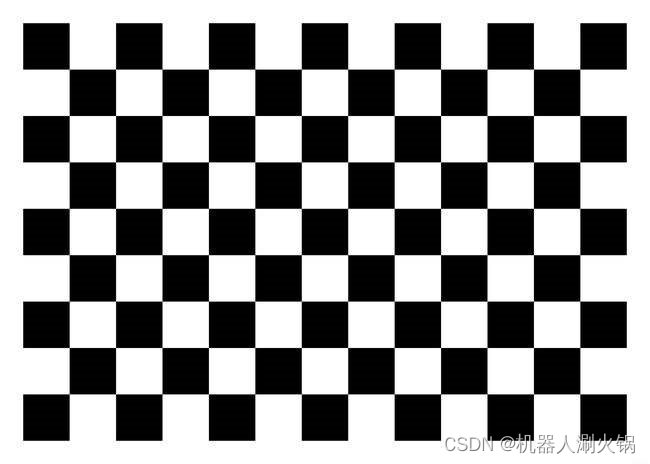1、准备工作
首先需要准备一张棋盘,如下图所示。对于标定不同测距范围相机所用的棋盘方格宽度会有所不同。对于短焦双目相机(测距范围在20m以内),棋盘中方格的宽度达到20mm即可;对于长焦双目相机(测距范围在40m左右),棋盘中方格的宽度需要尽量大,否则会影响标定的精度,一般至少达到60mm。

尽量拍摄多组照片,这样可以提高标定效果,标定效果的好坏直接影响到测距的精度。对于短焦相机通常拍摄40组照片即可;长焦相机通常会需要更多组照片,标定长焦相机时拍摄了60组。
2、 采集图像代码
如果使用的是左右图像拼接1个USB接口输出的双目摄像头,在采集图像时需要注意其图像拼接的顺序,例如我使用的双目摄像头拼接顺序从左至右为右目——左目(不知道是不是都是这么拼接的,还是厂家搞错了),这个问题处理不好可能会导致后面的处理结果都不对,所以这里特别说明一下。
import os
import argparse
import cv2
class StereoCamera(object):
"""采集双目标定图片,按键盘【c】或【s】保存图片"""
def __init__(self, chess_width, chess_height, detect=False):
"""
:param chess_width: chessboard width size,即棋盘格宽方向黑白格子相交点个数,
:param chess_height: chessboard height size,即棋盘格长方向黑白格子相交点个数
:param detect: 是否实时检测棋盘格,方便采集数据
"""
self.chess_width = chess_width
self.chess_height = chess_height
self.detect = detect
self.criteria = (cv2.TERM_CRITERIA_EPS + cv2.TERM_CRITERIA_MAX_ITER, 30, 0.001)
def detect_chessboard(self, image):
"""检测棋盘格并显示"""
gray = cv2.cvtColor(image, cv2.COLOR_BGR2GRAY)
ret, corners = cv2.findChessboardCorners(gray, (self.chess_width, self.chess_height), None)
if ret:
# 角点精检测
corners2 = cv2.cornerSubPix(gray, corners, (11, 11), (-1, -1), self.criteria)
# Draw and display the corners
image = cv2.drawChessboardCorners(image, (self.chess_width, self.chess_height), corners2, ret)
return image
def capture2(self, left_video, right_video, save_dir):
"""
用于采集双USB连接线的双目摄像头
:param left_video:int or str,左路视频路径或者摄像头ID
:param right_video:int or str,右视频路径或者摄像头ID
:param save_dir: str,保存左右图片的路径
:return:
"""
self.create_file(save_dir)
capL = cv2.VideoCapture(left_video)
capR = cv2.VideoCapture(right_video)
widthL, heightL, numFramesL, fpsL = self.get_video_info(capL)
widthR, heightR, numFramesR, fpsR = self.get_video_info(capR)
print("capL:\n", widthL, heightL, numFramesL, fpsL)
print("capR:\n", widthR, heightR, numFramesR, fpsR)
save_videoL = self.create_file(save_dir, "video", "left_video.avi")
save_videoR = self.create_file(save_dir, "video", "right_video.avi")
writerL = self.get_video_writer(save_videoL, widthL, heightL, fpsL)
writerR = self.get_video_writer(save_videoR, widthR, heightR, fpsR)
i = 0
while True:
isuccessL, frameL = capL.read()
isuccessR, frameR = capR.read()
if not (isuccessL and isuccessR):
print("No more frames")
break
if self.detect:
l = self.detect_chessboard(frameL.copy())
r = self.detect_chessboard(frameR.copy())
else:
l = frameL.copy()
r = frameR.copy()
cv2.imshow('left', l)
cv2.imshow('right', r)
key = cv2.waitKey(10)
if key == ord('q'):
break
elif key == ord('c') or key == ord('s'):
print("save image:{:0=3d}".format(i))
cv2.imwrite(os.path.join(save_dir+"/left", "left_{:0=3d}.png".format(i)), frameL)
cv2.imwrite(os.path.join(save_dir+"/right", "right_{:0=3d}.png".format(i)), frameR)
i += 1
writerL.write(frameL)
writerR.write(frameR)
capL.release()
capR.release()
cv2.destroyAllWindows()
def capture1(self, video, save_dir):
"""
用于采集单USB连接线的双目摄像头(左右摄像头被拼接在同一个视频中显示)
:param video:int or str,视频路径或者摄像头ID
:param save_dir: str,保存左右图片的路径
"""
self.create_file(save_dir)
cap = cv2.VideoCapture(video)
width, height, numFrames, fps = self.get_video_info(cap)
print("capL:\n", width, height, numFrames, fps)
save_videoL = self.create_file(save_dir, "video", "left_video.avi")
save_videoR = self.create_file(save_dir, "video", "right_video.avi")
writerL = self.get_video_writer(save_videoL, int(width / 2), height, fps)
writerR = self.get_video_writer(save_videoR, int(width / 2), height, fps)
i = 0
while True:
isuccess, frame = cap.read()
if not isuccess:
print("No more frames")
break
# 分离左右摄像头
# 注意:需要根据摄像头画面分割左右图像
frameL = frame[:, int(width / 2):, :]
frameR = frame[:, :int(width / 2), :]
if self.detect:
l = self.detect_chessboard(frameL.copy())
r = self.detect_chessboard(frameR.copy())
else:
l = frameL.copy()
r = frameR.copy()
cv2.imshow('left', l)
cv2.imshow('right', r)
key = cv2.waitKey(10)
if key == ord('q'):
break
elif key == ord('c') or key == ord('s'):
print("save image:{:0=3d}".format(i))
cv2.imwrite(os.path.join(save_dir+"/left", "left_{:0=3d}.png".format(i)), frameL)
cv2.imwrite(os.path.join(save_dir+"/right", "right_{:0=3d}.png".format(i)), frameR)
i += 1
writerL.write(frameL)
writerR.write(frameR)
cap.release()
cv2.destroyAllWindows()
@staticmethod
def get_video_info(video_cap):
width = int(video_cap.get(cv2.CAP_PROP_FRAME_WIDTH))
height = int(video_cap.get(cv2.CAP_PROP_FRAME_HEIGHT))
numFrames = int(video_cap.get(cv2.CAP_PROP_FRAME_COUNT))
fps = int(video_cap.get(cv2.CAP_PROP_FPS))
return width, height, numFrames, fps
@staticmethod
def get_video_writer(save_path, width, height, fps):
if not os.path.exists(os.path.dirname(save_path)):
os.makedirs(os.path.dirname(save_path))
fourcc = cv2.VideoWriter_fourcc(*'XVID')
frameSize = (int(width), int(height))
video_writer = cv2.VideoWriter(save_path, fourcc, fps, frameSize)
print("video:width:{},height:{},fps:{}".format(width, height, fps))
return video_writer
@staticmethod
def create_file(parent_dir, dir1=None, filename=None):
out_path = parent_dir
if dir1:
out_path = os.path.join(parent_dir, dir1)
if not os.path.exists(out_path):
os.makedirs(out_path)
if filename:
out_path = os.path.join(out_path, filename)
return out_path
def get_parser():
width = 12
height = 8
left_video = 0
right_video = -1
save_dir = "data/"
parser = argparse.ArgumentParser(description='Camera calibration')
parser.add_argument('--detect', type=bool, default=True, help='detect corner')
parser.add_argument('--width', type=int, default=width, help='chessboard width size')
parser.add_argument('--height', type=int, default=height, help='chessboard height size')
parser.add_argument('--left_video', type=int, default=left_video, help='left video file or camera ID')
parser.add_argument('--right_video', type=int, default=right_video, help='right video file or camera ID')
parser.add_argument('--save_dir', type=str, default=save_dir, help='YML file to save calibrate matrices')
return parser
if __name__ == '__main__':
args = get_parser().parse_args()
stereo = StereoCamera(args.width, args.height, detect=args.detect)
if args.left_video > -1 and args.right_video > -1:
# 双USB连接线的双目摄像头
stereo.capture2(left_video=args.left_video, right_video=args.right_video, save_dir=args.save_dir)
elif args.left_video > -1:
# 单USB连接线的双目摄像头(左右摄像头被拼接在同一个视频中显示)
stereo.capture1(video=args.left_video, save_dir=args.save_dir)
else:
raise Exception("Error: Check your camera{}".format(args.left_video, args.right_video))